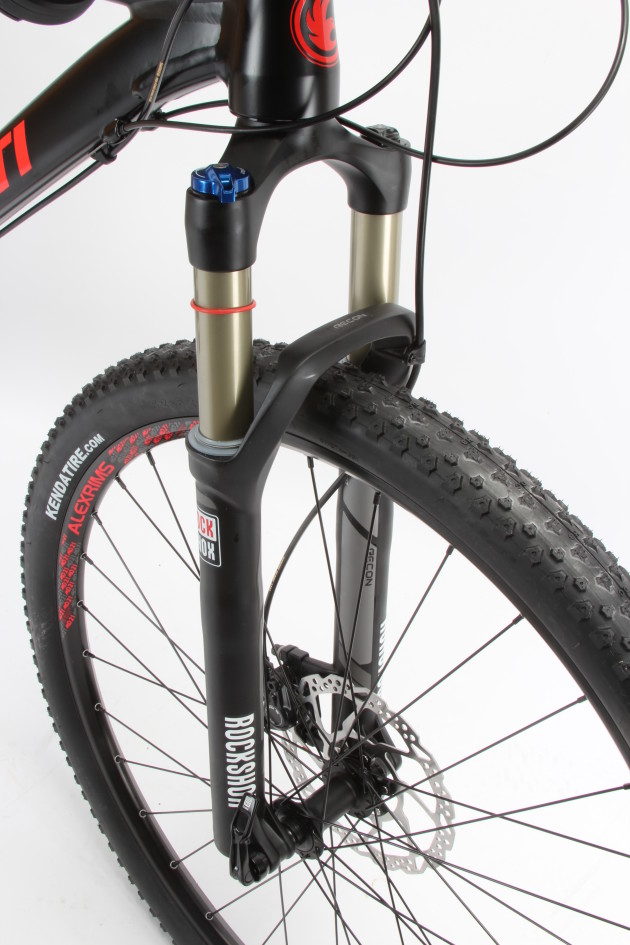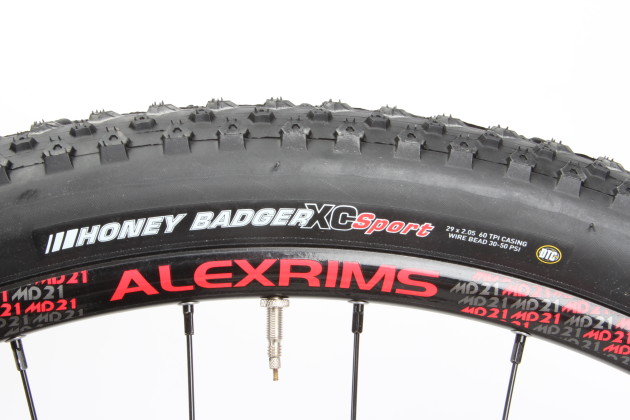Avanti Competitor 9.1
The only thing that is constant is change. Mountain bikers in 2015 know this as well as anyone; we could still be happily rolling around on 26 inch wheels but 29ers came along, and now we have 27.5 and fatbikes as well as ‘plus’ sized tyres and so on.
Sure, it took years for 29 to usurp the 26 inch wheel, but almost overnight 27.5 wheels have come charging through the berm and they seem to be accelerating towards the exit with vengeful ease. Avanti has heavily backed 27.5 wheels and currently the Competitor hardtail line is the only 29er in their performance MTB lineup—even the just released Competitor S dually rolls on 27.5 wheels.
The Competitor hardtail range includes three 29er hardtails; the C1 ($2,400) and C2 ($3,600) both feature a carbon frame while our 9.1 test bike relies on alloy construction and sells for $1,999. They also have an alloy 27.5 model – the Competitor 7.1 – which virtually mirrors the bigger wheeled 9.1. Avanti only offers the 9.1 in frame sizes from medium/large and up, while the 27.5 equipped Competitor 7.1 is offered in the small, medium and large sizes. This concept of matching wheel size to rider height seems to be gaining traction with a number of manufacturers these days. It certainly opens up the options for riders who sit in the middle ground, as they could go either way depending on their wheel size preference.

Avanti has completely redesigned the Competitor 9.1 for 2015. The frame is all new and it comes in one spec level only, in matte black no less. It’s a safe play that’s pitched squarely at the rider who’s looking for a value for money MTB, equipped with all the things you need and nothing that you don’t. The 9.1 is unlikely to polarise opinion, although admittedly it’s not often that a sub-$2,000 alloy 29er hardtail will really stir the pot.
Design Details
There’s a good deal of tube manipulation going on within the frame and some very tidy looking flat welds. The semi-oval down tube is quite substantial with an extra gusset tacked underneath where it meets the tapered head tube. The top tube carries similar proportions up front but tapers dramatically, becoming comparatively slender where it joins the seat tube. All in all there’s plenty of beef to support the thru-axle equipped RockShox Recon fork, ensuring you go exactly where you point it. The fork offers 100mm of travel, so it’s very much a cross-country build and the crown-mounted lock out lets you enter full-roadie mode for extended tarmac missions or smooth climbs.

While the front end lives large, the rear of the bike is quite the opposite. The seat stays are heavily ovalised and very minimalist with the goal of softening the ride. We commonly see this design on high-end carbon hardtails but it’s less common in alloy. There’s no escaping that this is a hardtail, but the Competitor is far from harsh or rough when compared with similar machines—it definitely surpassed our expectations in this regard.
As good as the ride quality was, we can’t help thinking they could have gone one better. Many newer hardtails run a skinny 27.2mm diameter seatpost to add some comfort-enhancing flex when seated. With the Competitor, Avanti opted for a fatter 31.6mm seatpost. They even list it as a ‘special feature’ on their website with the purported benefit of greater stiffness, leading to a direct connection with the frame. In an age of dual suspension bikes and wider and cushier tyres, the concept of intentionally sending trail chatter and impacts directly into the saddle seems somewhat odd, especially given the effort dedicated towards the slender stays.

As the name suggests, this is a ‘race focused’ or at least a ‘race inspired’ rig. Even if you won’t be entering any World Cup races with it, the Competitor delivers a sharp and responsive ride that’s best suited to short and intense efforts. If you wanted to make seated pedalling more forgiving, you could always shim the seat tube down to accept a 27.2 post. Ultimate Sports Engineering in the UK make good quality reducers (www.ultimatesportsengineering.com), although they generally make seat height adjustment a bit fiddly. On the flipside, the chubby diameter means you’ve the pick of the market for a dropper post, although there is no provision for cable routing on the frame and the ride character is overtly cross-country, so I doubt many Competitor owners will be shopping for a dropper post.
Avanti has stuck with a 135mm quick release rear axle, despite the prevalence of 142x12mm thru-axles as the default choice on most newly designed performance-oriented bikes. Avanti feels the regular quick release works sufficiency well – which it does – and they say it keeps the rear end as compliant as possible without unnecessarily increasing stiffness by using a thru-axle. All true I’m sure but the prime reason is primarily price-point related, which is fine by us on a sub-$2,000 XC machine. This is a ‘wheels on the ground’ sort of bike and the ride is certainly solid enough. While we’re growing more accustomed to seeing thru-axles on modern cross-country bikes, we had no real reason to lament its omission. The rear end tracks just fine and the old school quick release somehow managed to keep the wheel in the frame, as they’ve done for countless years.
While we’re talking about the rear wheel mounting point, the drop-outs are formed from a very chunky 3D shaped piece of alloy. On the left side it incorporates the disc mount, providing a very sturdy mounting point that’s tucked neatly out of harm’s way. The super-slim seat stays are a spin-off of this design, as the braking forces are handled by the drop-outs and the larger diameter chainstays. Neat little features such as this give the Competitor a modern look and it’s easily mistaken for a carbon frame when you stand at a distance.

Skinny Roller
Looking more closely and it’s apparent that the Competitor wasn’t designed with large volume tyres in mind. In stock form it comes with Kenda Honey Badger tyres mounted on 21mm internal width Alex rims. Marked as a ‘2.05’, the tyres certainly look narrow and the modest side knobs are more likely to amuse the trail than strike fear into its surface.
I swapped out the Honey Badgers for some more aggressive treads before hitting my local trails. Small volume tyres with minimalist tread generally don’t play well with loose, rock-strewn Sydney sandstone trails. There was clearance for Maxxis Ikon 2.2s but the back wheel would only have to go mildly out-of-true for it to rub on the chainstays. As it was, the tyre buzzed the rear deraill eur cable under hard cornering loads. We mentioned it to Avanti and were told this may be addressed in future. They also said the bike was designed as a lower price-point performance model and they felt that most owners would be likely to opt for narrower tyres like those spec’d.

The frame does offer excellent standover clearance, but it comes with a 350mm long post. I had to use a 400mm post to get the proper seat height. Having a long post with lots of clearance is definitely the go but we feel Avanti could have been more generous with the length of the stock post.
So the Competitor has the looks of a carbon frame with clearance for race-day tyres and Avanti backs this up with conservative and racy frame geometry. The chainstays are mid-to-long at 445mm and the head angle is steep at 72-degrees. It’s never going to win the race on the descents with its fast front end, limited travel and skinny treads. However, for short bursts of speed, non-technical singletrack and just about any situation that involves climbing, the Competitor is a very capable bike. The long top tube and fork lockout makes for a great fire road climber and an ideal marathon machine. It’s easy to settle into a climbing tempo or to drive along on the flat on this bike. If racing isn’t on the agenda, these same qualities make for a great A-to-B mile muncher that’s most comfortable on fire trails, dirt roads and smoother singletrack.

The highlight of the Competitor is certainly the frame. Despite its inbuilt limitations it is very light at 1,690g and could build into a deadly privateer XC-race bike over time. The understated look suits it well and the quality of finish is top-notch.
The spec-sheet is sensible and solid; there aren’t any headline grabbers or unnecessary carbon parts that come at the expense of some unseen but important component elsewhere—it’s a metaphorical matte black spec for a matte black bike. With a 22/36 chainring combination the double ring Deore crank was perfect, offering plenty of gearing range for off-road use. The omission of a true big ring may deter commuters, as will the lack of rack or mudguard mounts. It mightn’t offer the ultimate in do-it-all versatility, but we say hats off to Avanti for creating a dedicated MTB rather than a bling commuter!
The RockShox Recon Gold and Deore stoppers are also worth a mention as best in class performers. Other than weight, there is no reason why these bits would detract from the experience for 90% of riders. An upgrade to the Napoleon-length post would be great and we’d have loved to see a clutch rear derailleur in SLX or even Deore in place of the non-clutch XT unit, which allowed the chain to flap and clang about.

A large portion of 29er hardtails in this price bracket are double duty commuter bikes. That’s absolutely not the case with the Competitor. It’s a far more specific than you may assume at first glance. Trail-slaying fun and ragged descending speed isn’t on the agenda either but Avanti has other models will appeal to the recreational trail rider, like their new 120mm travel 27.5 equipped Competitor S for example. The Competitor 9.1 is long and light with fast steering and gearing that’s optimised for real mountain biking. Tyres may be getting fatter and wheel diameters shrinking along the way, but the Competitor 9.1 stands proud, skinny and tall as a pure cross-country machine in the traditional quick handling, fast rolling sense with a bit of modern comfort thrown in.

Thumbs up
Smooth riding frame
Uncompromised XC focus
Great gearing range
Thumbs down
Limited tyre clearance
Nervous at speed
Short seatpost

Specifications
Frame: ADT Custom 6061Ultralite Alloy
Fork: RockShox Recon Gold Solo Air 100mm travel
Headset: FSA Orbit
Handlebars: Zero Strike Pro Alloy Riser
Stem: Zero Strike Pro Alloy
Shifters: Shimano Deore
Front Derailleur: Shimano Deore
Rear Derailleur: Shimano XT
Cassette: Shimano HG50, 11/36 10-speed
Chain: Shimano HG54
Cranks: Shimano Deore 22/36
Bottom Bracket: Shimano Deore
Pedals: Nylon platform
Brakes: Shimano Deore
Rims: Alex MD21 Double-wall alloy
Hubs: Shimano Deore
Spokes: Stainless steel
Tyres: Kenda Honey Badger 2.05
Saddle: Zero Zealth
Seatpost: Zero Strike Pro Alloy 31.6mm
Weight: 12.5kg with 330g pedals (Large frame 1,690g)
Available Sizes: M/L, L (tested) and XL
Price: $1,999
Distributor: Sheppard Industries 1300 883 305 / www.avantibikes.com











